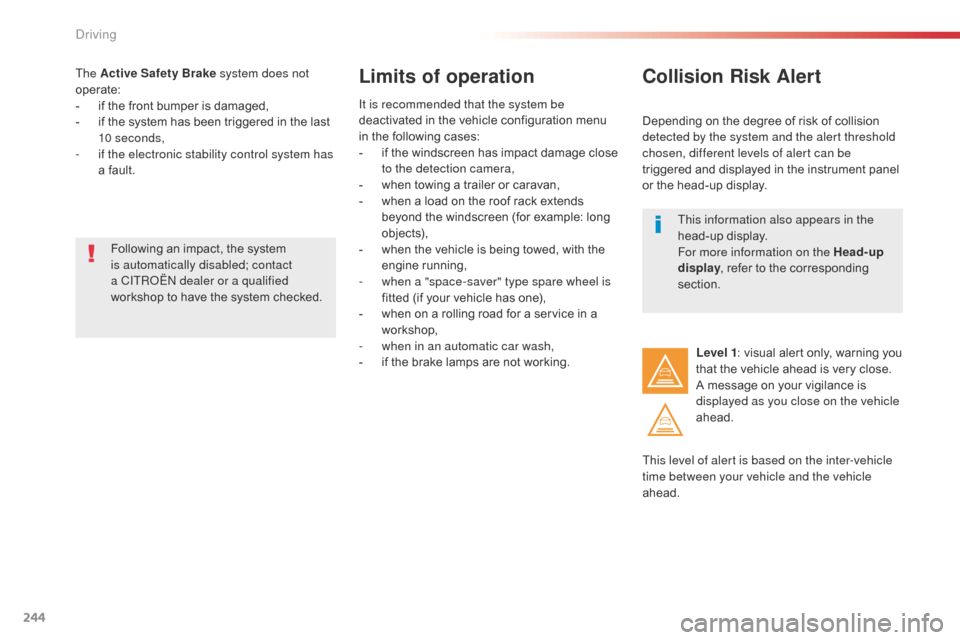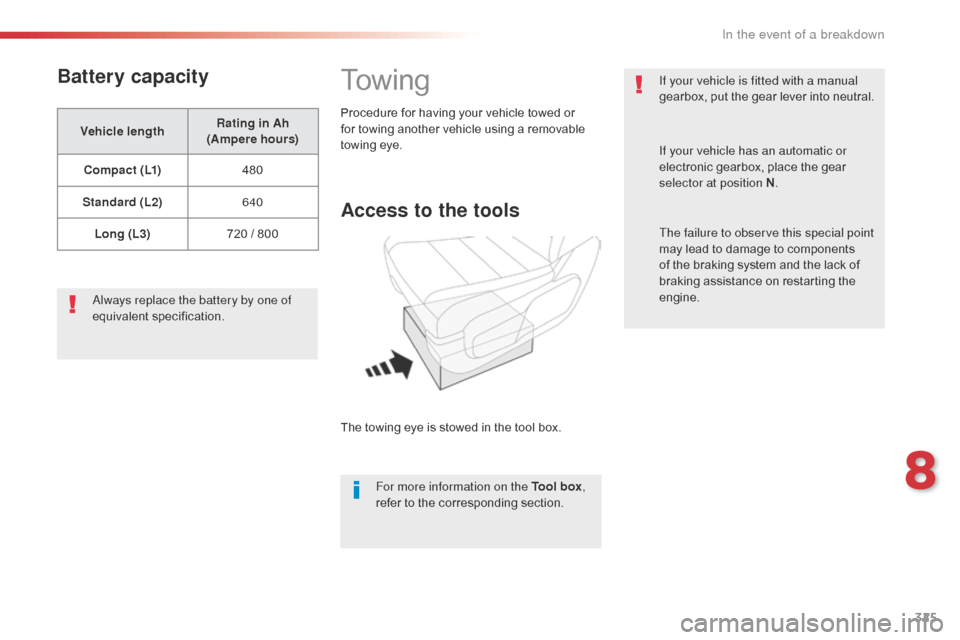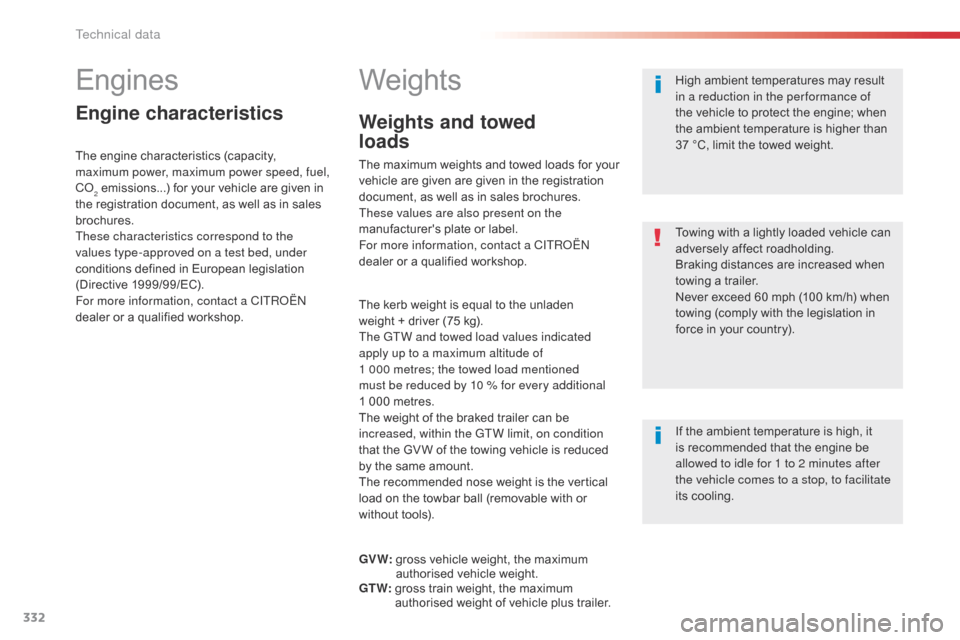towing Citroen JUMPY 2016 2.G User Guide
[x] Cancel search | Manufacturer: CITROEN, Model Year: 2016, Model line: JUMPY, Model: Citroen JUMPY 2016 2.GPages: 595, PDF Size: 12.47 MB
Page 246 of 595

244
Jumpy _en_Chap06_conduite_ed01-2016
The Active Safety Brake system does not
operate:
-
i
f the front bumper is damaged,
-
i
f the system has been triggered in the last
10 seconds,
-
i
f the electronic stability control system has
a fault.Limits of operation
It is recommended that the system be
deactivated in the vehicle configuration menu
in the following cases:
-
i
f the windscreen has impact damage close
to the detection camera,
-
w
hen towing a trailer or caravan,
-
w
hen a load on the roof rack extends
beyond the windscreen (for example: long
objects),
-
w
hen the vehicle is being towed, with the
engine running,
-
w
hen a "space-saver" type spare wheel is
fitted (if your vehicle has one),
-
w
hen on a rolling road for a service in a
workshop,
-
w
hen in an automatic car wash,
-
i
f the brake lamps are not working.
Following an impact, the system
is automatically disabled; contact
a CITROËN dealer or a qualified
workshop to have the system checked.
Collision Risk Alert
Depending on the degree of risk of collision
detected by the system and the alert threshold
chosen, different levels of alert can be
triggered and displayed in the instrument panel
or the head-up display.
This level of alert is based on the inter-vehicle
time between your vehicle and the vehicle
ahead. Level 1
: visual alert only, warning you
that the vehicle ahead is very close.
A message on your vigilance is
displayed as you close on the vehicle
ahead.
This information also appears in the
head-up display.
For more information on the Head-up
display
, refer to the corresponding
section.
Driving
Page 256 of 595

254
Jumpy _en_Chap06_conduite_ed01-2016
Operating fault
Have it checked by a CITROËN dealer or a
qualified workshop.The system may suffer temporary
interference in certain weather
conditions (rain, hail...).
In particular, driving on a wet sur face
or moving from a dry area to a wet area
can cause false alerts (for example, the
presence of a fog of water droplets in
the blind spot angle is interpreted as a
vehicle).
In bad or wintry weather, ensure that
the sensors are not covered by mud,
ice or snow.
Take care not to cover the warning zone
in the door mirrors or the detection
zones on the front and rear bumpers
with adhesive labels or other objects;
they may hamper the correct operation
of the system.
Depending on your vehicle's equipment:
With the touch screen
In the Driving
menu, activate/deactivate " Blind
spot monitoring ".
In the event of a fault, these warning lamps
flash.
The indicator lamp in this button
flashes and a message appears,
accompanied by an audible signal.
The state of the system remains in
memory on switching off the ignition.
The system is automatically deactivated
when towing with a towbar approved by
CITROËN.
High pressure jet wash
When washing your vehicle, do not
place the tip of the lance within 30 cm
of the sensors as otherwise there is a
risk of damaging them.
or
Driving
Page 263 of 595

261
Jumpy _en_Chap06_conduite_ed01-2016
Activation
Activation is automatic on engaging reverse.
The function is displayed in the touch screen.
To close the window displayed, press on the
red cross at the top left of the screen.On display of the sub-menu, select one of the
four views:
"Standard view".
"180° view".
"Zoom view".
"AUTO mode".
You can choose the display mode at any time
by pressing on this area. Check the cleanliness of the camera
lenses regularly.
Periodically clean the reversing camera
with a soft dry cloth.
"AUTO mode"
This mode is activated by default.
Using sensors in the rear bumper, the
automatic view allows a change from the rear
view to the view from above as an obstacle is
approached during a manoeuvre.
The system is automatically deactivated
when towing a trailer or carrying a
bicycle on the towbar (vehicle fitted with
a towbar installed as recommended by
the manufacturer).
Quick start mode
This mode displays, as quickly as possible, the
contextual view (left-hand part) and the view
from above the vehicle. High pressure jet wash (if muddy,
for
example)
When washing your vehicle, do not
place the tip of the lance within 30 cm of
the camera lenses, as otherwise there
is a risk of damaging them.
A message is displayed advising you to check
your vehicle's surroundings before starting the
manoeuvre.
6
Driving
Page 271 of 595

269
Jumpy _en_Chap07_info-pratiques_ed01-2016
Towing a trailer
We recommend the use of genuine
CITROËN towbars and their harnesses
that have been tested and approved
from the design stage of your vehicle,
and that the fitting of the towbar is
entrusted to a CITROËN dealer or a
qualified workshop.
If the towbar is not fitted by a
CITROËN dealer, it must still be
fitted in accordance with the vehicle
manufacturer's instructions.
Your vehicle is primarily designed for
transporting people and luggage, but it may
also be used for towing a trailer. Driving with a trailer places greater
demands on the towing vehicle and the
driver must take particular care.
For more information on Driving
advice,
particularly when towing, refer
to the corresponding section.
7
Practical information
Page 289 of 595

287
Jumpy _en_Chap08_En-cas-de-panne_ed01-2016
Warning triangle (stowing)
Before leaving your vehicle to set up
and install the triangle, switch on the
hazard warning lamps and put on your
high visibility vest.
This safety equipment should be used in
addition to the hazard warning lamps.
Its presence in the vehicle is mandatory.
Placing the triangle in the
road
Refer to the manufacturer's instructions on
unfolding and assembly supplied with the
triangle. F
P
lace the triangle behind the vehicle, as
required by the legislation in force in your
c o unt r y.
The triangle is available as an
accessory; contact a CITROËN dealer
or a qualified workshop.
Tool box
Access
The tool box is located under the left-hand front
seat.
As a safety measure, the bars 1 and
2
prevent the box escaping from its
housing, if it is not correctly secured.
8
In the event of a breakdown
Page 290 of 595

288
Jumpy _en_Chap08_En-cas-de-panne_ed01-2016
Stowing
F Press the latches A and slide them inwards to release the box.
F
L
ift the box slightly then pull it as far as it
will go to take it past bar 1 .
F
T
hen, lift the box upwards to take it past
bar 2 . F
U nclip the fixings B on the cover, then
open it for access to the tools.
OpeningRemoving
Pull on the box to check that it is secure
in its housing.
F
O
ffer up the box with the front inclined
upwards.
F
T
o take it past bar 2 , push the box in and
down. F
T
o take it past bar 1
, raise the box slightly
then push it fully in.
F
R
efit the cover on the box and clip the
fixings B. F
O
nce the box is fully home
in its housing,
push it against the floor carpet then slide
the latches A outwards to secure it.
In the event of a breakdown
Page 327 of 595

325
Jumpy _en_Chap08_En-cas-de-panne_ed01-2016
Battery capacity
Vehicle lengthRating in Ah
(Ampere hours)
C o m p a c t ( L1) 480
Standard (L2) 640
Long (L3) 720 / 800
Always replace the battery by one of
equivalent specification.
To w i n g
Access to the tools
The towing eye is stowed in the tool box. For more information on the Tool box ,
refer to the corresponding section.
Procedure for having your vehicle towed or
for towing another vehicle using a removable
towing eye.
If your vehicle is fitted with a manual
gearbox, put the gear lever into neutral.
If your vehicle has an automatic or
electronic gearbox, place the gear
selector at position N
.
The failure to observe this special point
may lead to damage to components
of the braking system and the lack of
braking assistance on restarting the
engine.
8
In the event of a breakdown
Page 328 of 595

326
Jumpy _en_Chap08_En-cas-de-panne_ed01-2016
F On the front bumper, press the cover (as shown above) to unclip it.
F
S
crew the towing eye in fully.
F
I
nstall the towing arm.
F
S
witch on the hazard warning lamps on the
towed vehicle.
F
M
ove off gently and drive slowly over a
short distance only.
Towing your vehicle
F On the rear bumper, press the cover (as shown above) to unclip it.
F
S
crew the towing eye in fully.
F
I
nstall the towing arm.
F
S
witch on the hazard warning lamps on the
towed vehicle.
F
M
ove off gently and drive slowly over a
short distance only.
Towing another vehicle General
recommendations
Observe the legislation in force in your
c o unt r y.
Ensure that the weight of the towing
vehicle is higher than that of the towed
vehicle.
The driver must remain at the wheel of
the towed vehicle and must have a valid
driving licence.
When towing a vehicle with all four
wheels on the ground, always use an
approved towing arm; rope and straps
are prohibited.
The towing vehicle must move off gently.
When towing a vehicle with the engine
off, there is no longer any power
assistance for braking or steering.
In the following cases, you must always
call on a professional recovery service:
-
v
ehicle broken down on a motor way
or fast road,
-
f
our-wheel drive vehicle,
-
w
hen it is not possible to put the
gearbox into neutral, unlock the
steering, or release the parking
brake,
-
t
owing with only two wheels on the
ground,
-
w
here there is no approved towing
arm available...
In the event of a breakdown
Page 334 of 595

332
Jumpy _en_Chap09_caracteristiques-techniques_ed01-2016
Engines
Engine characteristics
The engine characteristics (capacity,
maximum power, maximum power speed, fuel,
CO
2 emissions...) for your vehicle are given in
t
he registration document, as well as in sales
brochures.
These characteristics correspond to the
values type-approved on a test bed, under
conditions defined in European legislation
(Directive
1
999/99/EC).
For more information, contact a CITROËN
dealer or a qualified workshop.
Weights
The kerb weight is equal to the unladen
weight + driver (75 kg).
The GTW and towed load values indicated
apply up to a maximum altitude of
1
000 metres; the towed load mentioned
must be reduced by 10 % for every additional
1
000 metres.
The weight of the braked trailer can be
increased, within the GTW limit, on condition
that the GV W of the towing vehicle is reduced
by the same amount.
The recommended nose weight is the vertical
load on the towbar ball (removable with or
without tools). High ambient temperatures may result
in a reduction in the per formance of
the vehicle to protect the engine; when
the ambient temperature is higher than
37
°C, limit the towed weight.
If the ambient temperature is high, it
is recommended that the engine be
allowed to idle for 1 to 2 minutes after
the vehicle comes to a stop, to facilitate
its cooling. Towing with a lightly loaded vehicle can
adversely affect roadholding.
Braking distances are increased when
towing a trailer.
Never exceed 60 mph (100 km/h) when
towing (comply with the legislation in
force in your country).
GV W:
g
ross vehicle weight, the maximum
authorised vehicle weight.
GT W:
g
ross train weight, the maximum
authorised weight of vehicle plus trailer.
Weights and towed
loads
The maximum weights and towed loads for your
vehicle are given are given in the registration
document, as well as in sales brochures.
These values are also present on the
manufacturer's plate or label.
For more information, contact a CITROËN
dealer or a qualified workshop.
Technical data
Page 513 of 595

511
Jumpy_en_Chap11_index-alpha_ed01-2016
Unlocking the doors ............................ 80, 81, 83
Unlocking, total ................................... 4 7, 55, 60
Updating the date
............................4
6, 420, 476
Updating the time
............................ 4
6, 421, 477
USB
........
...................................... 122, 398, 454
Ventilation
............... 1
2, 125, 126, 131, 135, 136
Voice commands
.................................. 3
4 6 - 3 51
Warning and indicator lamps
..........................17
W
arning lamp, braking
system
................
........................................... 18
Warning lamp, Diesel engine pre-heater
...............................
......................21
Warning lamp, door(s) open
...........................20
W
arning lamp, driver''s seat belt not
fastened
...............
....................................... 168
Warning lamps
................................................ 17
W
arning lamp, SCR emissions
control system
.............................................. 2
7
Under-inflation
(detection)
...............................
.................... 262
Unlocking
..................... 4
7- 49, 55 -57, 59, 60, 63
Unlocking from the inside
.............................. 7
2, 73, 79 - 81, 83
Unlocking, selective
................ 4
7, 49, 55, 56, 60
Table of weights
........................... 333
, 335, 336
Table position
...............................
................. 101
Tables of fuses
.............................. 3
16, 317, 320
Table top, working
...............................
.......... 109
Tank, fuel
...............................
........................ 265
Technical data
.............................. 333
, 335, 336
Telephone
.................... 4
00, 402, 404, 406 - 411,
456, 458, 460, 462- 467, 497, 498, 500
Telephone, Bluetooth with voice recognition
........................................ 5
01
Temperature, coolant
................................ 1
9, 31
Third brake lamp
................................... 31
1, 314
Three flashes (direction indicators)
................................... 14
8
Time (setting)
..............................
.... 46, 421, 477
TMC (Traffic info)
.......................................... 3
67
Tool box
................
.................287, 289, 290, 296
V
W
U
T
To o l s ................ ..................................... 290, 296
Topping-up the AdBlue®
additive ...............
........................................ 285
Total distance recorder
................................... 38
T
ouch screen ......................................39, 43, 44,
89, 150 -152, 154, 158, 220, 226, 236, 245, 247, 249, 250, 254, 256, 264, 341, 429
To w b a r
................
.......................... 198, 269, 272
Towed loads
................................. 333
, 335, 336
Towing another vehicle
......................... 325
, 326
Towing eye
.................................................... 325
T
raction control (ASR)
............................ 2
5, 161
Traffic information (TA)
................................. 48
9
Traffic information (TMC)
.............................. 3
67
Tr a i l e r
...............
.....................................198, 269
Triangle, warning ........................................... 287
Trip computer
............................................ 4
0 - 42
Trip distance recorder
..................................... 38
T
ype of bulbs
................................................. 3
03
Ty r e s
..............................................................
..12
Tyre under-inflation detection
...............
....... 22, 262, 264, 295, 302
Stopping the vehicle
............ 2
02, 204, 209, 214
Stop & Start ................................ 2
2, 29, 42, 132,
135, 218, 220, 265, 276, 281, 321, 324
Stop (warning lamp)
........................................ 18
St
orage
................
.................. 105, 109, 117, 120
Storage compartments
......................... 12
0, 121
Storage wells
.........................................1
17, 120
Stowing rings
..............................
.................. 12 2
Sun visor
....................................................... 11
9
Switching off the engine
............................... 19
9
Synchronising the remote control
.....................................................5
4, 70
.
Alphabetical index